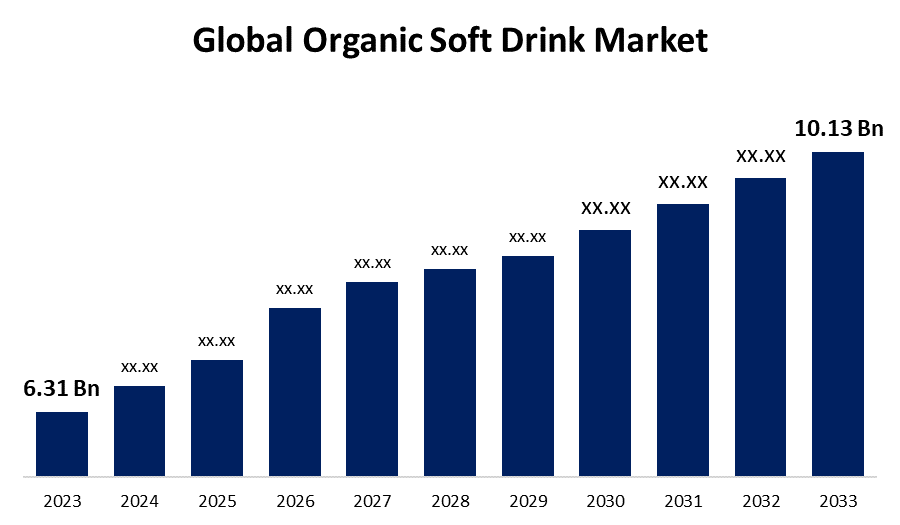Global Organic Soft Drink Market Size, Share, and COVID-19 Impact Analysis, By Product (Organic Soft Fruit Drinks, Organic Soda Pops, Others), By Packaging (Plastic, Glass, Paperboard, Metal), By Distribution Channel (Supermarket, Convenience Store, Online Store and Others), and By Region (North America, Europe, Asia-Pacific, Latin America, Middle East, and Africa), Analysis and Forecast 2023 - 2033
Industry: Food & BeveragesGlobal Organic Soft Drink Market Insights Forecasts to 2033
- The Global Organic Soft Drink Market Size was estimated at USD 6.31 Billion in 2023
- The Market Size is Expected to Grow at a CAGR of around 4.85% from 2023 to 2033
- The Worldwide Organic Soft Drink Market Size is Expected to Reach USD 10.13 Billion by 2033
- Asia Pacific is expected to grow the fastest during the forecast period.

Get more details on this report -
The organic soft drink market Size is expected to cross USD 10.13 Billion by 2033, growing at a CAGR of 4.85% from 2023 to 2033. The organic soft drink market growth is being driven by health trends, environmental concerns, ethical sourcing, and consumer demand for clean and natural products and Asia Pacific is an emerging key growth region.
Market Overview
The organic soft drink market is an industry division of beverages wherein organic ingredients are utilized for producing and selling soft drinks. Organic soft drinks are mostly free from the use of any synthetic pesticides and fertilizers, avoid any kind of genetic modifications, and follow natural methods of production. These include certified organic soft drinks, which may range from any type of carbonated beverages to juices, flavoured waters, teas, or even energy drinks. Moreover, strong growth in the organic soft drink market is due to rising consciousness about the beneficial effects of organic farming methods, concern for chemical pollutants in food and beverages, and a general trend toward healthy lifestyles. Innovations appear to be the focus of these manufacturers to launch flavors and formulations that meet the requirements for organic certification while being truly pleasurable in taste and quality. Each marketplace player constantly tries a plethora of tastes, strange pairings, and functional benefits to attract the target audience by incorporating vitamins, antioxidants, and herbal extracts that supposedly confer health benefits.
Report Coverage
This research report categorizes the organic soft drink market based on various segments and regions forecasts revenue growth and analyzes trends in each submarket. The report analyses the key growth drivers, opportunities, and challenges influencing the organic soft drink market. Recent market developments and competitive strategies such as expansion, type launch, development, partnership, merger, and acquisition have been included to draw the competitive landscape in the market. The report strategically identifies and profiles the key market players and analyses their core competencies in each sub-segment of the organic soft drink market.
Global Organic Soft Drink Market Report Coverage
| Report Coverage | Details |
|---|---|
| Base Year: | 2023 |
| Market Size in 2023: | USD 6.31 Billion |
| Forecast Period: | 2023 – 2033 |
| Forecast Period CAGR 2023 – 2033 : | 4.85% |
| 023 – 2033 Value Projection: | USD 10.13 Billion |
| Historical Data for: | 2019-2022 |
| No. of Pages: | 231 |
| Tables, Charts & Figures: | 115 |
| Segments covered: | By Product, By Packaging, By Distribution Channel, By Region |
| Companies covered:: | Wanakiki Kombucha Cobra Kombucha Nestle Blue Sky Beverages Dr Pepper Snapple Group HealthAde Brew Dr. Kombucha Tropical Grove Suntory Beverage and Food Reed’s CocaCola GT’s Living Foods Hain Celestial Monster Beverage PepsiCo Others |
| Pitfalls & Challenges: | COVID-19 Empact,Challenges, Future, Growth, & Analysis |
Get more details on this report -
Driving Factor
Consumers are becoming more conscious of the detrimental effects that sugary and artificially flavored soft drinks pose to their health. Organic soft drinks, which are usually lower in sugar and contain no artificial additives, introduce a healthier alternative for the health-conscious consumer. The organic soft drinks market is witnessing a tremendous surge, owing to all the health-conscious consumers seeking natural beverages with neither natural nor synthetic content. The trend of introducing and using natural ingredients like stevia and monk fruit extracts is now sending sales skyrocketing for them. Many organic beverage manufacturers are coming up with innovations, flavors, and ingredients, as well as functional drinks like kombucha, organic herbal teas, and probiotic sodas. This kind of innovation attracts more consumers who seek unique, refreshing, and healthy alternatives to traditional soft drinks.
Restraining Factors
Organic soft drinks are generally priced higher than their conventional counterparts since they require organic ingredients, sustainable farming methods, and eco-friendly packaging. Price-sensitive consumers find this higher price point prohibitive, especially in low-income regions with the competition of many mass-produced lower-cost soft drinks.
Market Segmentation
The organic soft drink market share is classified into product, packaging, and distribution channels.
- The organic soft fruit drinks segment accounted for the highest share in 2023 and is projected to grow at a substantial CAGR during the forecast period.
Based on the product, the organic soft drink market is divided into organic soft fruit drinks, organic soda pops, and others. Among these, the organic soft fruit drinks segment accounted for the highest share in 2023 and is projected to grow at a substantial CAGR during the forecast period. The growth is attributed to organic fruit drinks such as juices, flavored waters, and smoothies; their popularity increased among consumers looking for a natural, refreshing, and healthy alternative to sugary sodas. Organic fruit juices are available in different flavors such as orange, apple, berry, and tropical fruits. They provide a much wider range of flavor possibilities and thus attract a larger market potential than organic sodas or niche organic soft drinks.
- The glass segment dominated the market in 2023 and is anticipated to grow at a significant CAGR during the forecast period.
Based on the packaging, the organic soft drink market is divided into plastic, glass, paperboard, and metal. Among these, the glass segment dominated the market in 2023 and is anticipated to grow at a significant CAGR during the forecast period. The segmental growth is due to glass packaging being perceived to be more premium, which is in line with the positioning of organic products. Consumers see the glass as a more natural, sustainable, and safer packaging material, especially for beverages marketed as healthier and greener. Glass is also preferred, not only for its transparency and clean appearance but also because such aesthetic reasons can be persuasive to buyers of nourishing liquids.
- The supermarket segment accounted for the biggest share in 2023 and is expected to grow at a substantial CAGR during the forecast period.
Based on the distribution channel, the organic soft drink market is divided into supermarkets, convenience stores, online stores, and others. Among these, the supermarket segment accounted for the biggest share in 2023 and is expected to grow at a substantial CAGR during the forecast period. The growth is driven by supermarkets providing wide distribution and easy access to large consumers. Most consumers prefer doing their shopping at one point. Supermarkets offer an array of products, including organic beverages. Most supermarkets organize organic products into separate sections. This allows shoppers to find organic soft drinks alongside other health products. Thus, these stores create a ready market for these drinks.
Regional Segment Analysis of the Organic Soft Drink Market
- North America (U.S., Canada, Mexico)
- Europe (Germany, France, U.K., Italy, Spain, Rest of Europe)
- Asia-Pacific (China, Japan, India, Rest of APAC)
- South America (Brazil and the Rest of South America)
- The Middle East and Africa (UAE, South Africa, Rest of MEA)
North America is anticipated to hold the largest share of the organic soft drink market over the predicted timeframe.

Get more details on this report -
North America is anticipated to hold the largest share of the organic soft drink market over the predicted timeframe. The U.S. is indeed the largest market for organic soft drinks due to high demand in the country concerned with health-oriented products. The growing interest in health and wellness, as well as burgeoning awareness of environmental and sustainability issues, has also contributed to increased consumption of organic beverages. The existing infrastructure for organic product certification in the U.S. encourages consumers to trust and hence make organic selections convenient.
Asia Pacific is expected to grow at a rapid CAGR in the organic soft drink market during the forecast period. A wellness trend is stirring in countries such as China, India, and Japan. Consumers are gradually turning towards natural and functional foods and beverages for health, wellness, and longevity in these countries. Organic soft drinks, perceived to have the functional benefits of detoxification, hydration, and improved digestion, are resonating with cultural shifts.
Competitive Analysis:
The report offers the appropriate analysis of the key organizations/companies involved within the organic soft drink market along with a comparative evaluation primarily based on their type of offering, business overviews, geographic presence, enterprise strategies, segment market share, and SWOT analysis. The report also provides an elaborative analysis focusing on the current news and developments of the companies, which includes type development, innovations, joint ventures, partnerships, mergers & acquisitions, strategic alliances, and others. This allows for the evaluation of the overall competition within the market.
List of Key Companies
- Wanakiki Kombucha
- Cobra Kombucha
- Nestle
- Blue Sky Beverages
- Dr Pepper Snapple Group
- HealthAde
- Brew Dr. Kombucha
- Tropical Grove
- Suntory Beverage and Food
- Reed's
- CocaCola
- GT's Living Foods
- Hain Celestial
- Monster Beverage
- PepsiCo
- Others
Key Target Audience
- Market Players
- Investors
- End-users
- Government Authorities
- Consulting And Research Firm
- Venture capitalists
- Value-Added Resellers (VARs)
Recent Development
- In December 2024, Saudi Arabia launched Milaf Cola, touted as the world's first date-based soft drink. Produced by Thurath Al-Madina, this healthy alternative to traditional sodas utilizes locally sourced dates, having natural sweetness and nutritional benefits. The company plans to further its date-based beverage line, as a symbol of the will of Saudi Arabia toward health, sustainability, and economic diversification.
Market Segment
This study forecasts revenue at global, regional, and country levels from 2023 to 2033. Spherical Insights has segmented the organic soft drink market based on the below-mentioned segments:
Global Organic Soft Drink Market, By Product
- Organic Soft Fruit Drinks
- Organic Soda Pops
- Others
Global Organic Soft Drink Market, By Packaging
- Plastic
- Glass
- Paperboard
- Metal
Global Organic Soft Drink Market, By Distribution Channel
- Supermarket
- Convenience Store
- Online Store
- Others
Global Organic Soft Drink Market, By Regional Analysis
- North America
- US
- Canada
- Mexico
- Europe
- Germany
- UK
- France
- Italy
- Spain
- Russia
- Rest of Europe
- Asia Pacific
- China
- Japan
- India
- South Korea
- Australia
- Rest of Asia Pacific
- South America
- Brazil
- Argentina
- Rest of South America
- Middle East & Africa
- UAE
- Saudi Arabia
- Qatar
- South Africa
- Rest of the Middle East & Africa
Frequently Asked Questions (FAQ)
-
1. What is the CAGR of the organic soft drink market over the forecast period?The global organic soft drink market is projected to expand at a CAGR of 4.85% during the forecast period.
-
2. What is the market size of the organic soft drink market?The global organic soft drink market size is expected to grow from USD 6.31 billion in 2023 to USD 10.13 billion by 2033, at a CAGR of 4.85% during the forecast period 2023-2033.
Need help to buy this report?